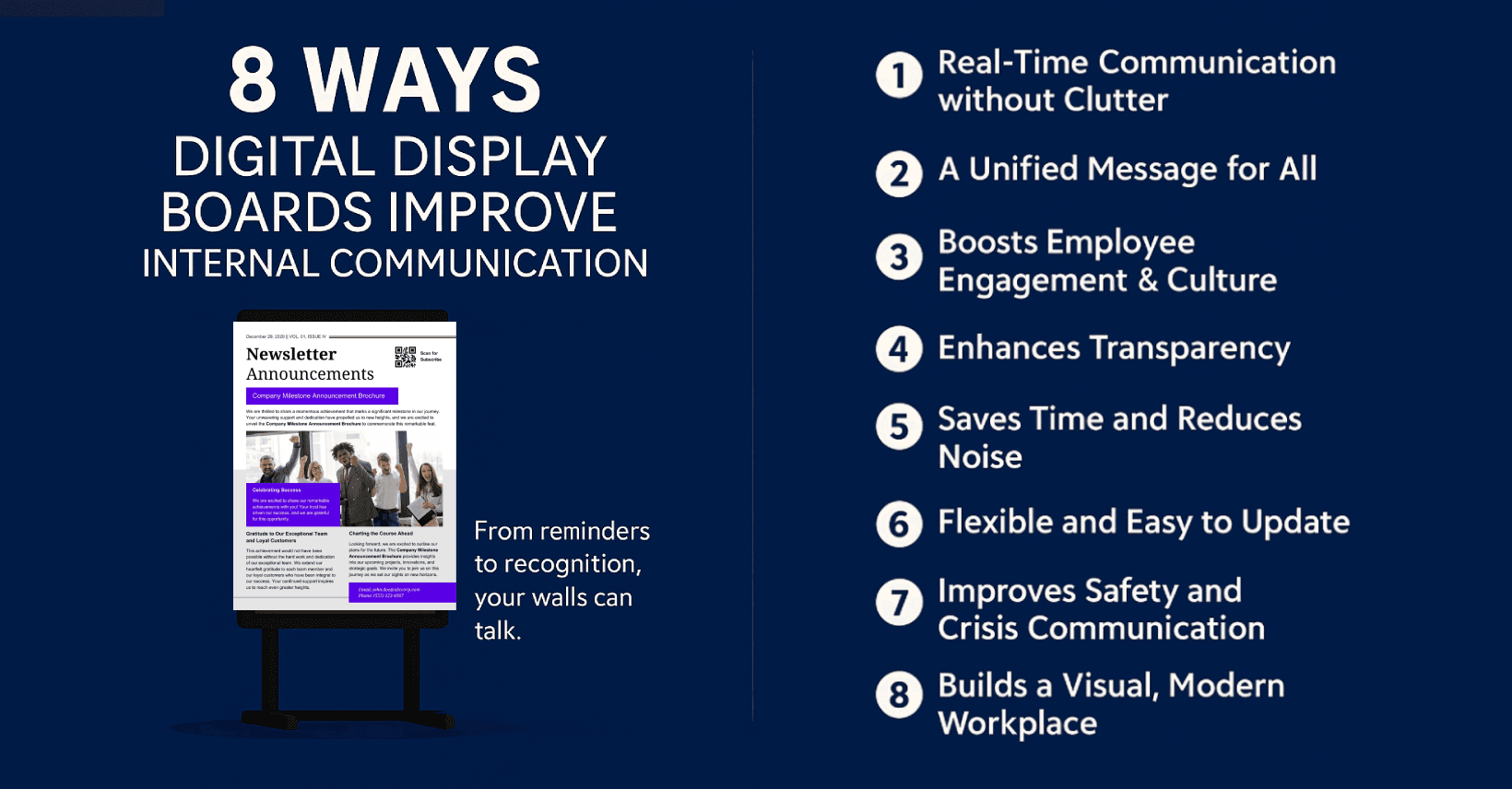
###Ensuring Clear and Consistent Communication Through Dynamic Digital Signage in Schools:
Effective communication is the foundation of a healthy community in the complex fabric of educational contexts. Schools prioritize consistency and clarity in their communications and are always looking for new and creative ways to efficiently share information with parents, teachers, and students. With the introduction of digital signs, school communication has entered a completely new era that is marked by increased clarity and unwavering uniformity in all aspects of information distribution.
Clarity: Accuracy at the Foundation of Communication
-
Effective communication is built on clarity, which is a foundational component that guarantees both message reception and comprehension. Digital signage provides an audience with a multimodal experience by offering a multitude of formats, from text and images to movies and animations.
-
Important notifications, event schedules, safety instructions, and academic updates can all be easily seen and understood by drawing attention to them.
-
Furthermore, mastery of concision is essential. Students and teachers benefit from material that is clear and visually exciting in an era where people's attention spans are short.
-
With the use of eye-catching graphics or concise text, digital signage enables educational institutions to present complex information in a way that is easy to understand and retain, reducing confusion and increasing understanding
-
Multimedia components are added to communication efforts to further enhance them. Videos that highlight student initiatives, school accomplishments, or inspirational material engage and excite the school community and promote a feeling of pride and cohesion.
Consistency: The Pillar of Reliability in Messaging
-
Establishing consistency in communication is essential for establishing dependability and trust. Digital signage guarantees that messages are shown uniformly in different places across the school.
-
Everyone receives the same information simultaneously, whether in access points, common areas, or hallways, greatly lowering the possibility of miscommunication or inaccuracy.
-
Additionally, maintaining a consistent visual identity and promoting the school's image and ideals is made possible by matching design components and branding across all displays.
-
A unified communication strategy is created by maintaining consistency in design components like colors, typefaces, and logos. This improves engagement by making content easily recognizable.
-
Sturdy content rotations and frequent updates help to reinforce consistency. Digital signage makes it easy to update information—daily announcements, forthcoming events, schedule changes, etc.—while guaranteeing that it stays current and relevant.
-
Maximizing Potential: Implementing Best Practices for Effective Digital Signage Usage
Integration with Curriculum and Educational Content:
-
By displaying pertinent educational content and integrating with the curriculum, digital signage can be used as an instructional tool.
-
Educational films, motivational sayings, historical details, or provocative messages in line with lesson plans or theme units can be shown in schools. This method expands the educational experience outside of the classroom while also reinforcing what is learned.
-
Schools can develop a seamless blend of academic enrichment and information dissemination by using digital signage as an educational resource. This will encourage continual learning within the school environment.
Schools can communicate more effectively with digital signage by:
-
Content planning is the process of putting together an extensive content schedule that is in line with important dates, academic calendars, and school events. Keeping engagement high by ensuring a balance of instructive, entertaining, and informative content.
-
Engaging Visuals: Capturing attention and successfully communicating ideas through the use of sharp photos, vivid colors, and eye-catching designs.
-
Interactive Components: Including interactive elements to promote interaction and offer extra materials or information, such as touch screens or QR codes.
-
Audience targeting assures relevance and maximizes engagement by customizing communications for various school audience segments, including parents, instructors, and students.
-
Evaluation and feedback: Regularly collecting input to gauge the success of digital signage messaging and implementing any required alterations or enhancements in light of the information gleaned.
Enhancing and Revolutionary Educational Communication with Wauly Digital Signage Solutions.
A healthy educational community is built on effective communication. In order to improve communication within educational institutions, digital signage emerges as a dynamic solution that focuses on uniformity and clarity.
Schools may create an environment that is favorable to collaborative learning and growth by utilizing the potential of digital displays to strengthen community relationships and increase engagement.Discover the power of digital signage in education. Contact us for more information and revolutionize your school's communication!!
Recent blogs
Most Recent blogs

What Is Digital Signage? How It Can Help Your Business
Discover what digital signage is, how it works, and why it's revolutionizing communication across industries. Explore its key benefits, real-world applications, and how to get started.
Read More
Outdoor DIGITAL Displays : A Comprehensive Guide
Explore our expert guide to outdoor digital displays—featuring key features, benefits, pricing insights, and 2025 trends to help you choose the ideal digital signage solution for your brand.
Read More
6 Reasons Why You Need a Portable Digital Standee Today
Discover 6 powerful reasons to choose a portable digital standee enhance visibility, reduce costs, and captivate your audience with dynamic digital signage.
Read More
How Digital Display Boards Improve Internal Communications
Explore how digital display boards transform internal communication by providing real-time updates, increasing employee engagement, and promoting transparency in the workplace across various industries.
Read More
Expert Guide: Navigating the Active LED Digital Screens Market
LED Video Wall market: Understand the quality spectrum and make informed choices for your digital signage needs with Wauly Digital Signage.
Read More






